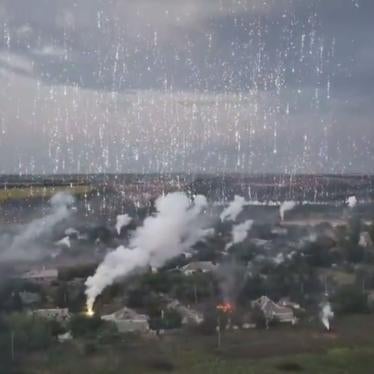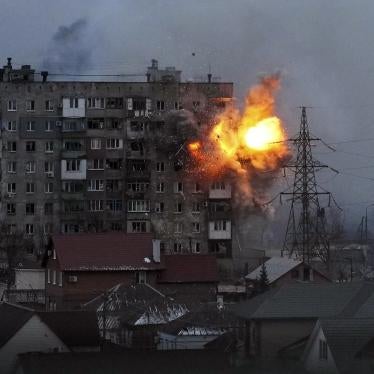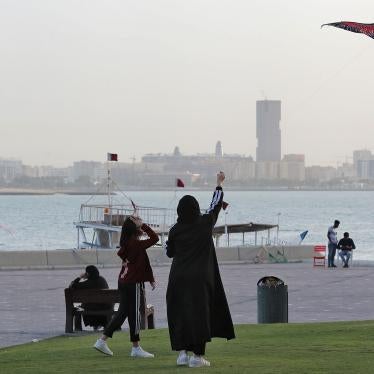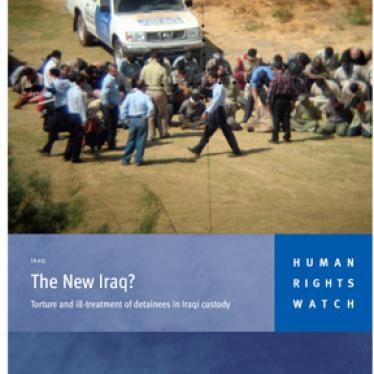Shortcomings of Protocol III on Incendiary Weapons
Incendiary weapons contain different chemical compounds, such as napalm or thermite, that ignite and cause significant human suffering at the time of attack and in the weeks, months, and even years that follow. Protocol III to the Convention on Conventional Weapons (CCW), which has 117 states parties, seeks to protect civilians from the use of these weapons. The protocol, however, has two loopholes that have undermined its effectiveness:
- By describing incendiary weapons as those “primarily designed” to set fires or burn humans, Protocol III’s definition of incendiary weapons excludes most multipurpose incendiary munitions. The definition does not encompass munitions, such as white phosphorus, that are “primarily designed” to create smokescreens or signal troops, yet have the same cruel incendiary effects.
- Protocol III prohibits the use of air-dropped incendiary weapons in concentrations of civilians, but the provision on ground-launched incendiary weapons includes several caveats that weaken it. This arbitrary distinction ignores the fact that incendiary weapons cause horrific burns and destructive fires regardless of their delivery mechanism.
Recommendations
To strengthen civilian protection from incendiary weapons, governments should:
- Adopt a mandate at the CCW Meeting of High Contracting Parties to hold informal consultations to assess the adequacy of Protocol III;
- In the interim, hold discussions outside the CCW to evaluate national and international measures to address the concerns raised by incendiary weapons, and to consider ways to create stronger international standards;
- Express their views on the adequacy of Protocol III;
- Condemn the use of incendiary weapons and raise awareness of the harm they cause; and
- Close Protocol III’s loopholes and further stigmatize the use of incendiary weapons. A complete ban on incendiary weapons would have the greatest humanitarian benefits.
The Human Cost of Incendiary Weapons
Incendiary weapons are notorious for their horrific human cost. White phosphorus munitions produce similarly cruel injuries to other weapons with incendiary effects, despite falling outside the definition of incendiary weapons under Protocol III to the Convention on Conventional Weapons.
Immediate Effects
In the immediate aftermath of their use, incendiary weapons cause:
- Extensive and excruciating burns that require painful treatment. White phosphorus inflicts particularly deep burns and can reignite when bandages are removed;
- Respiratory damage from inflamed airways and toxic fumes;
- Infection, extreme dehydration, and organ failure; and
- Psychological trauma from injuries and treatment.
Long-Term Physical Harm
Those who survive the initial injuries caused by incendiary weapons often face a lifetime of suffering. Long-term physical harm includes:
- Intense, chronic pain;
- Severe scarring and loss of mobility;
- Hypersensitivity to temperature, excessive skin dryness, and dead nerve endings;
- Brain damage from shock or hypoxia;
- Restricted growth in children; and
- Need for lifelong physical treatment.
Long-Term Psychological Harm
Ongoing psychological harm and social and economic impacts include:
- Post-traumatic stress (PTSD), anxiety, and depression;
- Need for lifelong mental health support; and
- Detachment from society and inability to work or attend school.
Challenges to Treatment
Caring for the victims and survivors of incendiary weapons presents numerous challenges, including:
- Difficulty of treating burn injuries, which is exacerbated in armed conflict;
- Inadequate specialized supplies and equipment;
- Shortage of medical and burn experts;
- Lack of knowledge about how to treat incendiary weapon injuries;
- Few professional ambulances for transfers to better facilities;
- Gaps in continuity of long-term care;
- Deprioritization of or limited resources for mental health support; and
- Trauma to medical personnel.
Recent Use of Incendiary Weapons in Ukraine
Over the past 15 years, Human Rights Watch has documented the use of incendiary weapons in Afghanistan, Gaza, Iraq, Syria, Ukraine, and Yemen. Incendiary weapons have been used most recently in the armed conflict in Ukraine, which began with Russia’s full-scale invasion of the country in February 2022.[1]
Human Rights Watch has reviewed visual evidence showing that there were at least 82 attacks in Ukraine using surface-fired incendiary weapons between February 2022 and April 2023. A total of 72 videos posted to social media to date, and tracked by Human Rights Watch, showed incendiary weapons attacks in process across at least seven of Ukraine’s regions, including Dnipropetrovska, Donetska, Kharkivska, Kyivska, Luhanska, Mykolaivska, and Zaporizka regions. At this time, it is not possible to attribute responsibility for specific attacks, but Russia and Ukraine both possess the same types of incendiary weapons, including 122mm Grad rockets that deliver incendiary weapons.
Positions on Incendiary Weapons and Protocol III
At the CCW’s Sixth Review Conference in December 2021 and at a subsequent CCW Meeting of High Contracting Parties held in November 2022, 24 states, the European Union, the International Committee of the Red Cross (ICRC), and non-governmental organizations raised concerns over the use of incendiary weapons. Almost all states that spoke on the issue called for setting aside time for the CCW to discuss incendiary weapons further. [2]
Much of the debate centered around a proposal suggesting the CCW chair conduct informal consultations on the implementation and universalization of Protocol III before the next Meeting of High Contracting Parties. Ireland initially tabled the proposal at the 2021 Review Conference, where it was rejected by Cuba and Russia because the CCW operates by consensus.[3] At the 2022 meeting, Russia again blocked agreement on the proposal submitted this time by Switzerland on behalf of Austria, Ireland, Mexico, New Zealand, and Norway.[4]
The Sixth Review Conference did not set aside dedicated time to discuss Protocol III or incendiary weapons, but repeated almost verbatim the language from the Fifth Review Conference’s final document, as follows:
Notes the concerns raised by a number of High Contracting Parties over reports of use of incendiary weapons against civilians and condemns any use of incendiary weapons against civilians or civilian objects, and any other use incompatible with relevant rules of International Humanitarian Law, including provisions of Protocol III where applicable.
Statements Addressing Concerns on Incendiary Weapons at 2021-22 CCW Meetings
|
|
Condemned or expressed concern about use |
Supported informal consultations during the intersessional period |
Supported further discussion, including through a separate agenda item |
Called for amending or strengthening Protocol III |
|
Argentina |
|
|
X |
X |
|
Australia |
X |
X |
X |
|
|
Austria |
X |
X |
X |
X |
|
Belgium |
X |
X |
X |
|
|
Chile |
X |
X |
X |
X |
|
Colombia |
X |
|
X |
X |
|
Costa Rica |
X |
|
X |
X |
|
Ecuador |
X |
|
X |
|
|
Germany |
X |
X |
X |
|
|
Holy See |
X |
|
X |
X |
|
Ireland |
X |
X |
X |
|
|
Mexico |
X |
X |
X |
X |
|
Netherlands |
X |
X |
X |
|
|
New Zealand |
X |
X |
X |
|
|
Norway |
X |
X |
X |
|
|
Palestine |
X |
X |
X |
X |
|
Panama |
X |
X |
X |
X |
|
Peru |
|
X |
X |
|
|
Philippines |
X |
|
X |
X |
|
Spain |
X |
|
|
|
|
Switzerland |
X |
X |
X |
|
|
Ukraine |
X |
|
X |
|
|
United Kingdom |
X |
|
|
|
|
Uruguay |
|
|
X |
|
|
European Union |
X |
|
X |
|
|
ICRC |
X |
X |
X |
|
|
Civil Society |
X |
X |
X |
X |
Condemnation or Concern over Use
"Incendiary weapons are among the most inhumane in warfare. They can inflict excruciating burns and respiratory damage, for which specialized medical attention is generally unavailable in areas of armed conflict. The use of incendiary weapons can also cause profound psychological trauma. The burning of homes, infrastructure, and crops results in long-lasting socioeconomic harm and creates long-lasting legacy suffering." - Joint statement by Switzerland, on behalf of Austria, Ireland, Mexico, New Zealand, and Norway (2022 Meeting of High Contracting Parties (2022 MHCP))
"Austria is among the many countries that are deeply concerned about the humanitarian impact costs by use of incendiary weapons and in particular the unacceptable suffering these weapons inflict. In recent years, we have received continued reports about the use of incendiary weapons in Afghanistan, Gaza, Iraq, Syria, Yemen and Ukraine." - Austria (2022 MHCP)
"On the use of incendiary weapons, we would like to vigorously condemn its use." - Ecuador (2022 MHCP)
"The EU remains concerned about the reported use of incendiary weapons against civilians or against targets located within a concentration of civilians, their indiscriminate use causing cruel effects and unacceptable suffering." - European Union (2022 MHCP)
"The ICRC, like many others, has repeatedly expressed serious concern about the humanitarian consequences of the use of incendiary weapons, and of weapons with incidental incendiary effects, such as white phosphorus munitions. We are in particular alerted by the sharp increase of reported uses of incendiary weapons in the past year." - ICRC (2022 MHCP)
"We're concerned in particular by the devastating effect of the increased use on civilian populations including immediate lesions and the physical, psychological, and social economic long-lasting effect with a marked gender dimension. Quite frequently victims particularly women and girls are marginalized and stigmatized due to their … scars. It also leads to fires that destroy civil infrastructure, and it leads to the loss of biodiversity. We strongly condemn the use of these weapons by any actor and for any reason given that they violate international humanitarian law and it is an affront to human conscience." - Panama (6th Review Conference)
Calls for Consultations or Agenda Item
"In light of the severe humanitarian concerns around the use of incendiary weapons and weapons with incidental incendiary effects, we believe it is timely for the CCW to meaningfully discuss the implementation of Protocol III, as well as to consider measures to bolster its universalization.... CCW High Contracting Parties have a responsibility to take action." - Joint statement by Switzerland, on behalf of Austria, Ireland, Mexico, New Zealand, and Norway (2022 MHCP)
"We would like to express our concern about the absence on the agenda of the Meeting of the High Contracting Parties to the CCW of an item related to Protocol III on incendiary weapons in order to review this instrument with a view to strengthening and with a view to reducing the humanitarian impact of these weapons." - Argentina (2022 MHCP)
"This modest proposal simply asked to hold dedicated, open and informal consultations on Protocol III universalization and implementation which is entirely appropriate within the CCW and is necessary particularly given the reported recent use of incendiary weapons." - Ireland (2022 MHCP)
"We think it is desirable that there be a mandate for the chair of the Committee to have open informal consultations and to include an agenda item on the subject to evaluate the universalization and implementation of the protocol." - Panama (2022 MHCP)
"Switzerland continues to support a discussion in the CCW to examine whether Protocol III adequately protects civilians and combatants from the serious effects of weapons regulated by this instrument." - Switzerland (2022 MHCP)
"We regret that Protocol III issues were removed from the CCW agenda because of the opposition by one high contracting party, and we request to have them back next year." - European Union (2022 MHCP)
"In view of the pattern of use of incendiary weapons and weapons with incidental incendiary effects in the recent and ongoing armed conflicts, it is timely to further the discussion on the humanitarian impact of these weapons, the adequacy of existing protections afforded to civilians and combatants, and the implementation of Protocol III." - ICRC (2022 MHCP)
"In light of the great humanitarian consequences of the use of incendiary weapons and weapons with incendiary effects incidentally, … Chile supports Ireland’s proposal on carrying out informal consultations." - Chile (6th Review Conference)
"Mexico believes that we have to look at the gaps that have been left open by Protocol III.… This should continue to be an issue for the future meetings." - Mexico (6th Review Conference)
Calls to Strengthen or Amend Protocol III
"We see clear value in strengthening Protocol III in order to prevent the insidious harm caused by these weapons." - Austria (2022 MHCP)
"Costa Rica would like to join other high contracting parties that launched an appeal to continue our review of Protocol III as quickly as possible. We have to use this opportunity and strengthen those points of the document that are still pretty weak." - Costa Rica (2022 MHCP)
"The allegations of the use of incendiary weapons that have been reported demand the launch of an honest, technical, and legal review of the provisions contained in Protocol III. Such an exercise is warranted by the need to improve and strengthen protection from the harmful effects of incendiary weapons, and not simply out of military or political convenience." - Holy See (2022 MHCP)
"Almost all of the states who spoke on the topic [at the 2021 Review Conference] supported setting aside time in 2022 to discuss Protocol III. CCW states parties should summon the energy for humanitarian action they exhibited at the 2021 Review Conference and not let last year’s consensus-driven setback deter them from future work on incendiary weapons." - Human Rights Watch, on behalf of Amnesty International, Article 36, Campaña Colombiana Contra Minas, Mines Action Canada, Mines Advisory Group, PAX, Seguridad Humana en América Latina y el Caribe (SEHLAC), and Women’s International League for Peace and Freedom (2022 MHCP)
"Given their cruel effects it is a humanitarian imperative to strengthen international law related to those weapons, notably by adopting an effects-based definition of incendiary weapons in Protocol III that covers multipurpose munitions." - Palestine (6th Review Conference)
"We see value in strengthening Protocol III, including its adequacy in dealing with the humanitarian harm posed by white phosphorus." - Philippines (6th Review Conference)
Additional Human Rights Watch and IHRC Resources
Briefing Paper: “Unchecked Harm: The Need for Global Action on Incendiary Weapons” (November 2022)
Report: "They Burn Through Everything": The Human Cost of Incendiary Weapons and the Limits of International Law (November 2020)
Briefing Paper: “Myths and Realities about Incendiary Weapons” (November 2018)
Video: “Incendiary Weapons: Explainer” (March 2023)
Video: “Incendiary Weapons: Human Cost Demands Stronger Law” (November 2020)
For more information, please contact Bonnie Docherty, docherb@hrw.org or bdocherty@law.harvard.edu.
[1] Human Rights Watch and the Harvard Law School International Human Rights Clinic (IHRC), "Unchecked Harm: The Need for Global Action on Incendiary Weapons," November 2022, https://www.hrw.org/sites/default/files/media_2022/11/incendiariesreport_11.08_final.pdf.
[2] For CCW Sixth Review Conference statements, see UN Web TV Recording, CCW Sixth Review Conference, Geneva, December 13-17, 2021, https://media.un.org/en/asset/k1n/k1nz8pifxs (accessed May 1, 2023). For CCW Meeting of High Contracting Parties statements, see UN Audio Files, CCW Meeting of High Contracting Parties, Geneva, November 16-18, 2022, https://conf.unog.ch/digitalrecordings/?guid=public/61.0490/549C8523-1127-4E95-956F-FD6A04684F72_10h15&position=0&channel=ORIGINAL (accessed May 1, 2023).
[3] For an overview of Review Conference proceedings, see Reaching Critical Will, CCW Report, vol. 9, nos. 10-13, December 14-17, 2021, https://reachingcriticalwill.org/disarmament-fora/ccw/2021/revcon/reports (accessed May 1, 2023).
[4] For an overview of Meeting of High Contracting Parties proceedings, see Reaching Critical Will, CCW Report, vol. 10, no. 11, November 22, 2022, https://reachingcriticalwill.org/images/documents/Disarmament-fora/ccw/2022/hcp-meeting/reports/CCWR10.11.pdf (accessed May 1, 2023).







